How do wave pools work? 7 ways machines make waves
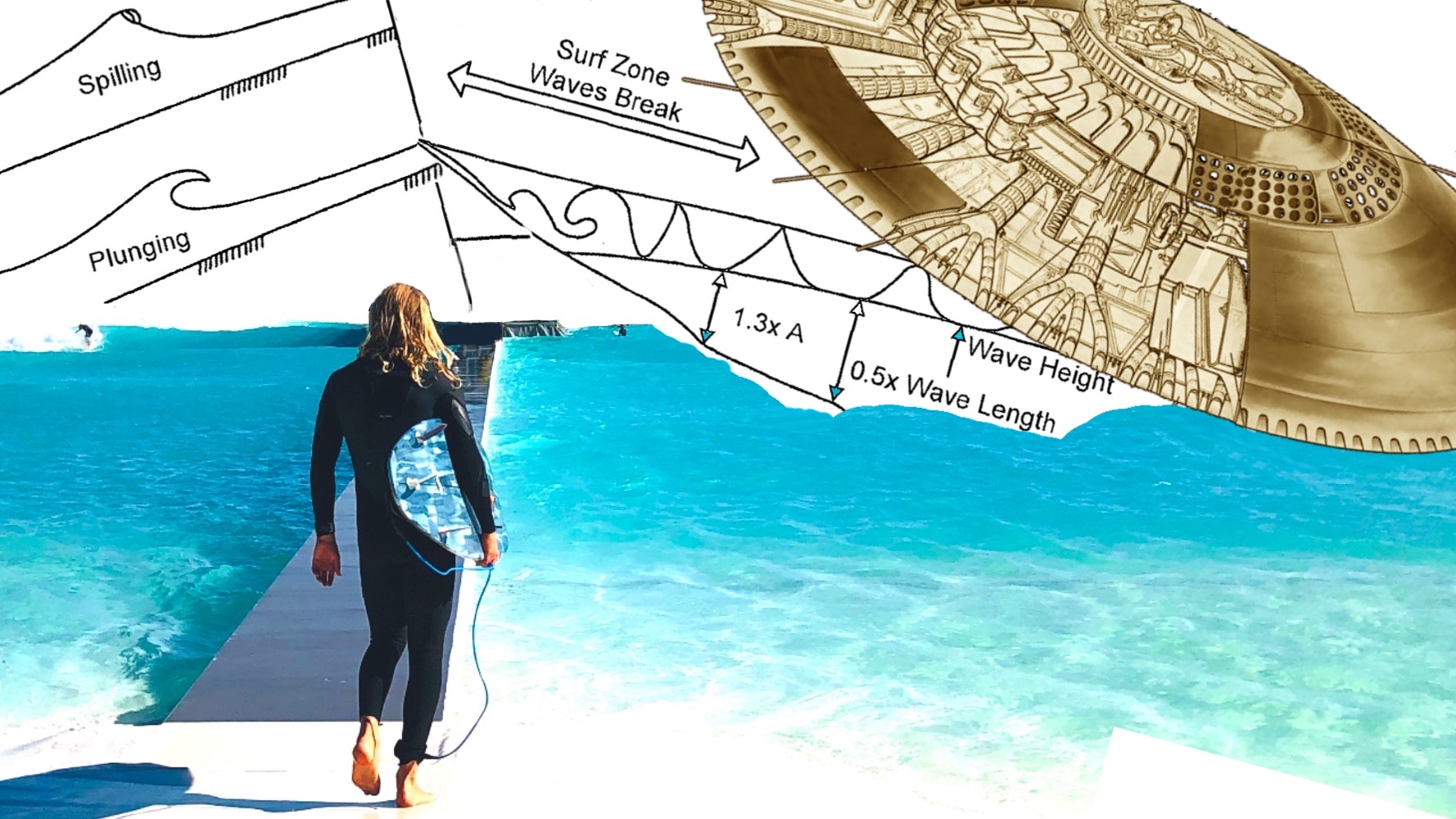
Engineering is a monster. And personally, it scares me. Why? Because stacking cinderblocks and building things in only one shape (square!) is pretty much the peak of my engineering accomplishments. But I love to surf, especially in wave pools. So thankfully the world has Wavegardens, PerfectSwells, SurfLochs, Surf Lakes, and a few others. And these companies love to engineer waves.
But the trippy thing is, there are only a handful of techniques used to physically displace water in such a way as to create waves. Currently, foiled plows, air compression (pneumatics), levers, dumped water, spinning blades, and plungers are the hot ways to make a wave for surfing. Of course this, like so much technology, could change in a heartbeat – laserbeams anyone?
Some water displacement techniques are more popular than others due to return on investment factors like building costs, reliability, and wave-per-hour frequency. For this article, we stuck to the proven (and most likely soon-to-be proven technologies). With more technologies emerging rapidly, this is as comprehensive a guide to current methods as we could produce.
The price of wave-making machines for a surf park can differ by millions of dollars. Right now there are backyard poolers out there without the financial or name brand backing of a Kelly Slater. For this pocket-protector set, it can be an impossible struggle to move from making a mini-wave pool to getting funding for the concrete pour on a five-acre facility.
So engineers please read on. Then go make your own surf spot so that your next “wave pool near me” search reveals an epic peeler in your backyard. And, hey, if you need help stacking cinderblocks, call us. We offer competitive rates.
Plow Method
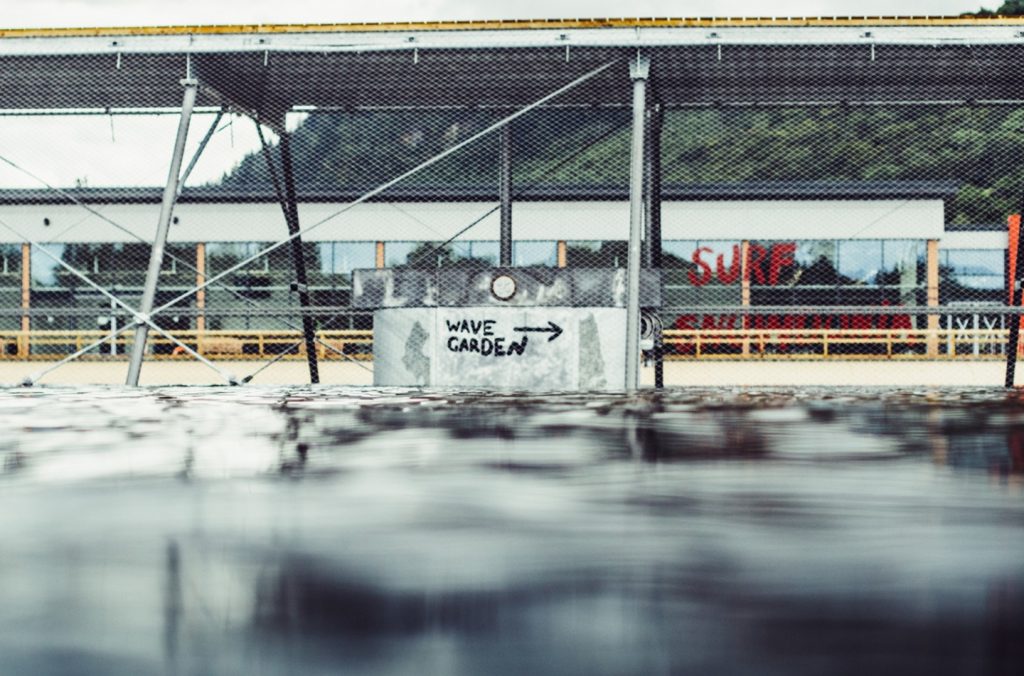
Surf Poel, Kelly Slater Wave Company, the Xing Feng center, and early Wavegarden tech all use the plow method. It works by pulling a submerged foil along a straight track down the center or side of a body of water. The hull, designed to maximize water displacement, pushes out a large wake that breaks along either one side or both sides of a central track.
“The patented technology of the Wavegarden Lagoon consists of a state-of-the-art hydrodynamic wave foil, powered by a gearless drive system similar to a ski lift’s, and working in combination with a revolutionary lagoon bathymetry,” says Wavegarden of their first design. “In-house-developed dissipative shores reduce backwash and currents to enable a higher wave frequency. The wave foil moves at a speed between 4.5m and 7.5m (14.7ft-24.6ft) per second along the central channel under the pier, displacing water to form a glassy swell.”
Once the swell is pushed out it interacts with the shallows of the lagoon and specialised bathymetry to form the desired wave. Check the below three variations of the Plow Method. While all three use the same basic principles in physics, the results are extremely different at each surf park.
While both the Wavegarden plow and Xing Feng Extreme Sports Center push out surf that is soft by many standards, there is a secondary, smaller “back wave” that has a more top-to-bottom shape. Some speculate that Kelly’s wave pool design eliminated the front wave and focused all the energy on this harder-breaking-back wave.
Five years ago the world frothed for the first public surf park, as Wavegarden delivered at Surf Snowdonia. But at the same time, the Basque Company was busy developing a new design to overcome the wave-to-customer ratio. You can read all about the Wavegarden Cove technology further along in this article.
Advantages:
Excellent beginner and longboarder waves on slower plows
Firing barrels for 45-second rides on Kelly’s model
Disadvantages:
Take off zone is small and easy to miss
Wave doesn’t surf quite like an ocean wave
Always surfing toward the central foil and machinery
Only one wave every 90-180 seconds or so, limiting the pool’s capacity
Air Compression System (aka Pneumatic or Blower)
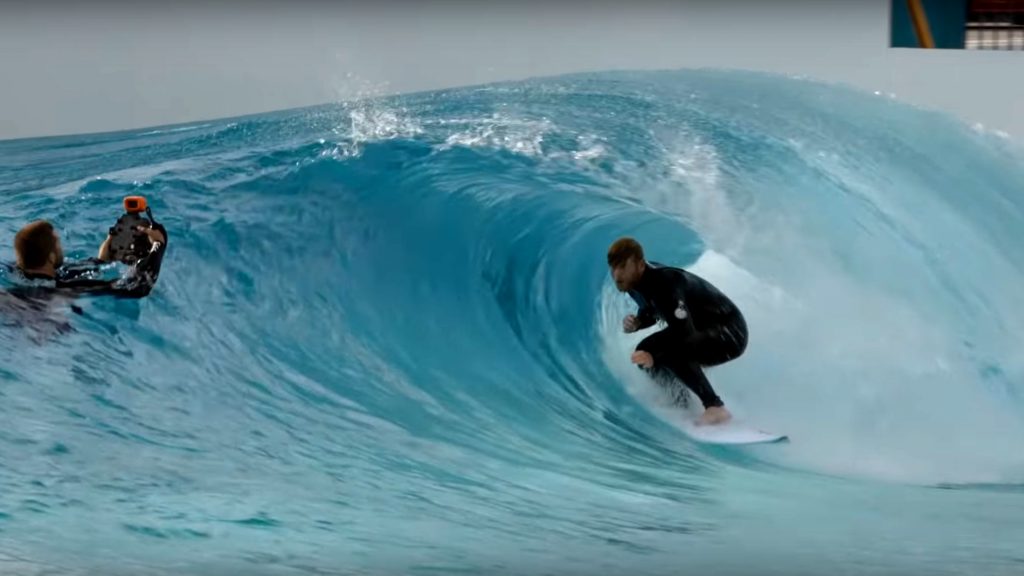
Air compression wave generation works by displacing water with the rapid, powerful pumping of air. The pressure forced through the water pushes out swell on either a macro or micro level. When dozens of air compression jets are fired in a particular sequence, almost any desired wave size, shape, and hollowness can be generated.
Surf Loch recently made headlines when it was announced to the world that their tech would be powering the highly anticipated Palm Springs Surf Club. Surf Loch uses air-compression (or pneumatics) to push out waves from a deep-end wall. The same technique, although tweaked quite differently is used to power PerfectSwell.
Although it’s the same basic principle in physics, both designs produce very different waves. Take a look at the two clips below and the variety of waves generated by air compression.
A great illustration of the variety of surf possible in this system is American Wave Machines’ flagship wave pool at BSR Surf Resort in Waco. Over the last two years, they’ve shown the world customized barrels, signature air sections, and the Freak Peak. Their PerfectSwell technology also powers the Far Far A Bay indoor pool in New Jersey.
Like most wave pool systems, surfers will ride toward the machine that drives the waves (or wall housing the air jets in this case). However, an option mentioned on the American Wave Machines’ website says surf park operators can upgrade to something called Infinite Ocean model.
Waterpark pioneer and inventor of the Flowrider Tom Lochtefeld uses pneumatics for his Surf Loch wave machines. The company says a combination of vacuum and pressure working within custom-designed concrete chambers releases energy into open water independently of each other. “The controlled variations of the independent pulses can generate an infinite variety of wave swells.”
“Surf Loch can easily operate our Palm Springs system with a wave every 7.5 seconds, i.e., 480 waves per hour,” Tom Lochtefeld told us. “However, the operator (Cheyne Magnusson) prefers not to. Therefore, it is just more a function of operator desire. Other factors can also come into play, e.g., rider interference in the event of a wipeout, or current formation and its effect on the wave.”
Advantages:
Totally customizable waves
Waves feel like ocean waves
Relatively few moving parts, so fewer breakdowns
Much of the equipment is stock and easily available
Disadvantages:
Surfing toward a wall in some designs
Coordinated Levers (Paddles)
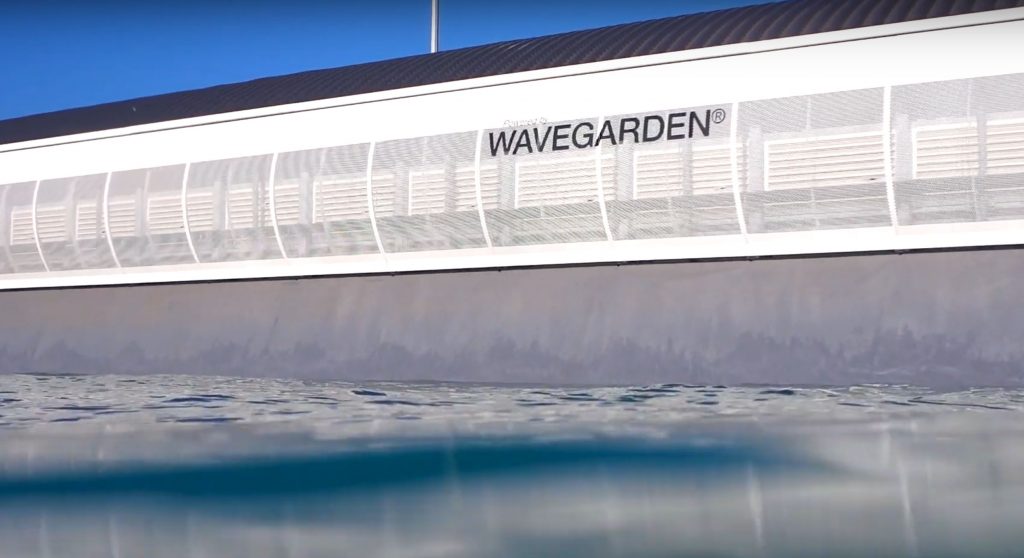
The lever water displacement method is the secret behind the Wavegarden Cove and how it works. There are several small levers inside a module that fire in sequence to push out waves. The wave-making machine is composed of several of these modules, 52 to be precise. With the help of refraction off a concrete wall, the Cove can deliver great surf in a variety of shapes and sizes.
Several other smaller companies are starting to use this technique. And if they can navigate the minefield of patents, we could see an algae bloom of new pool technologies. Along with WavePrizms one recent up and comer SwellSpot uses 10 large levers to push out waves. They are just getting started, so for now, Wavegarden Cove does it best and has the proven track record. So we’ll focus on them.
The patented levers are controlled by sophisticated software that Wavegarden states “at the push of a button, the size, shape, power, and frequency of the waves can be adjusted to suit all user groups.” They boast further that the software can transform conditions in an instant. Knee-high dribblers can be replaced with Cove slabs capable of hitting a max height of 2.4 meters (7 feet, 10 inches.) Another bonus, each module moves in a harmonious sequence to continually inject energy into the waves as they move forward. If you want a longer wave, just add more modules.
Advantages
Adjustable wave settings
High waves-per-hour count
One failed lever won’t stop the surf
Proven technology by wave pool 2.0 leaders Wavegarden
Disadvantage
With the wall and the central pier, space can feel confined
Big-Ass Plunger
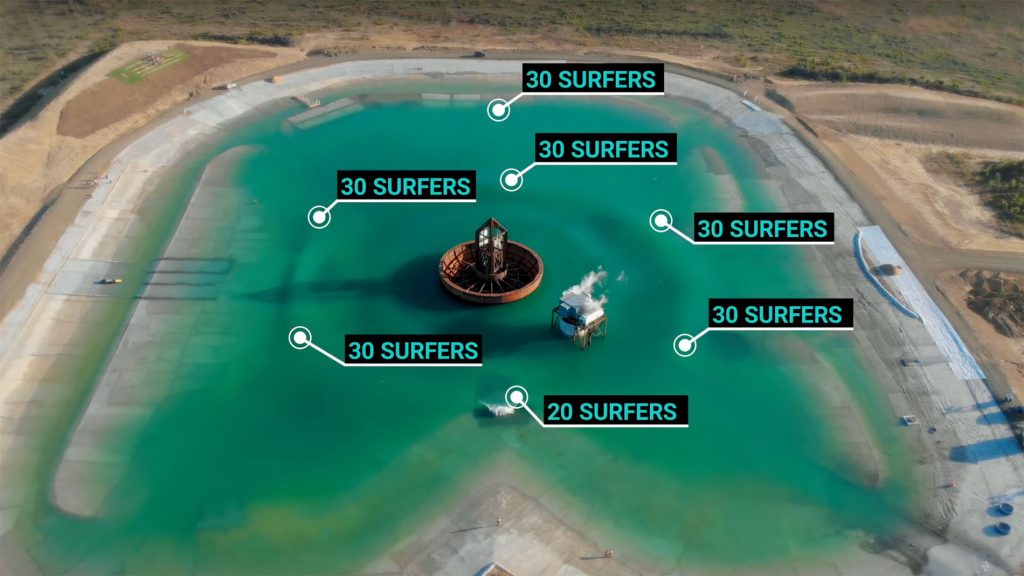
It’s so simple, it’s brilliant. Other companies have tried to create waves with a giant, central donut but only Surf Lakes has gone ahead and produced a surf-able prototype.
The plunger works like a stone dropped in a pond. Once the behemoth hub is depressed it sends out waves in 360 degrees. Anyone who has used a bobber while fishing has seen the little ripples it creates when a fish takes the bait. Surf Lakes works like this.
Technically, compressed air powers Surf Lakes. The air moves a huge lever that pushes down on the plunger to send waves out in concentric circles. As the wave fans out from the center it meets different surf breaks including the Slab, Occy’s Peak, and a beach break.
“We have eight breaks, so when we run six waves per set, this gives 48 rides per set, so running 50 sets per hour gives 2400 rides, plus learner breaks and shore breaks,” says Founder Aaron Trevis.Waves can reach 2.4 meters in height at the scaled back test facility. Full-size commercial facilities will produce larger waves. By building such a large wave pool, Surf Lakes says they will be able to accommodate 200-to-240 surfers at a time.
Advantages
Lots of waves per hour.
Variety of breaks for different levels
Not surfing toward a wall or fencing
Large lakefront area keeps open beach feeling
One swell hits five different breaks with lefts and rights
Intermediates and advanced can surf during the same session
Disadvantages
Large space required
Energy intensive
Noisy
Water Dump Technique
Ok, so how does the big surf wave pool work? It, uh, works like a toilet. Water is pumped into a waiting reservoir tank. Once filled, the water can be suddenly released into a waiting pool. The resulting force displaces enough water to create a wave. The surge travels all the way to the beach in the form of a crumbly wave. The only way to control the size and shape of the wave is by the amount of water dropped into the deep end. Dumping more water increases the size and strength of the wave.
Big Surf Arizona is the godfather of the wave pool surf dream. The park inspired the tale of Rick Kane in North Shore and today offers surfing hours to a dedicated crew of locals. And while we may mock the technical aspects of the wave, just remember it was 50 years ago they built the pool. Definitely the Kelly Slater Wave Company of the Day.
The modern-day most famous water dump facility is Wadi Adventure in Dubai, the one from Dion Agius’ Electric Blue Heaven video.
Advantages
Kicked off the wave pool dream
Great learner wave
Disadvantages
Unable to control wave specifics
Energy intensive
Weak surf
Sit and Spin
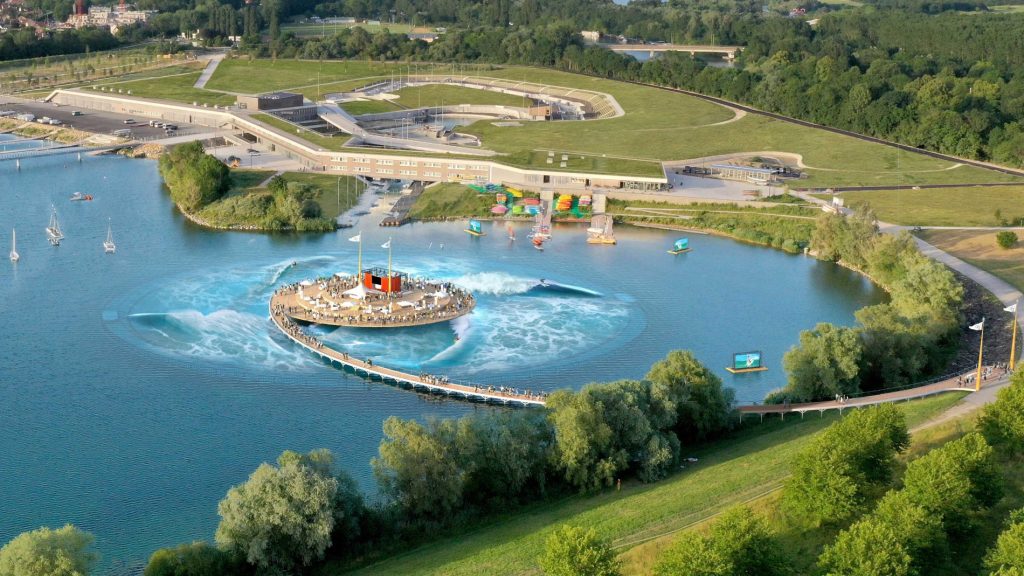
Okahina Wave is the leader in the newly formed “sit’n’spin” wave creation genre. They are the only ones at this time. While the company is highly secretive of just how the system works, the artist renderings show a machine that resembles a disc, spinning out waves from a central hub. On the very outer edge of the circular design sits a deep spot to absorb the wave action and prevent erosion of nearby shores.
The formation of this wavemaker is unique in that it was developed under an environmental framework. The Okahina Wave device can be deployed in lakes, ponds, bays, and elsewhere providing habituate for fish and aquatic plants while aerating “dead” water areas. Oh, and create a new surf spot.
How does it work? And, does it work? We don’t know. But the world should get its first view of the technology in October of this year adjacent to the Futuroscope in Poitiers France.
Advantages
Environmentally focused
Could be as easy to deploy as ramps at a cable park
Disadvantages
Unproven shred-ability factor
Center Island
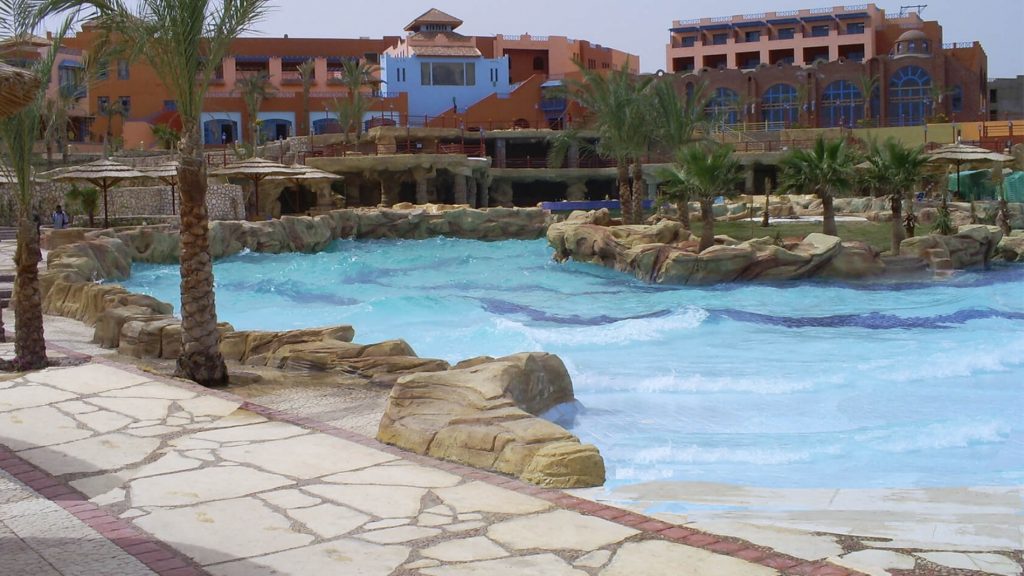
This is one of the most highly prized concepts in our collective wave pool psyche. Disneyland had one in the 1970s kitted out with surf-making paddles that worked so well it eroded nearby shorelines.
Murphys Waves has a central island design although it’s not surf-focused but made for tourists. The Waves 360 Series from Murphys is a step in the right direction. The system comes in several different sizes and performance variations.
“The waves are produced from an innovative center island which can be designed and themed to suit the overall layout of the park,” says Murphys.
The company wouldn’t divulge if the surf is generated by pushing out water through pneumatics, levers, or water dump, so we’ll classify the center island as its own particular wave-making beast. Why? There are heaps of dreamed-up circular surfing wave pools out there and to this day it’s the Holy Grail of wave pool designs. For a full breakdown on the donut, dream check out our article right here
Advantages
360-degree “endless ride”
Small footprint that keeps large beach area
The most oft-dreamed of design for wave pools
Disadvantages
No surf-specific model…. just yet
Related Coverage
